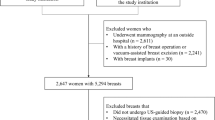Abstract
Purpose
Liquid crystal display (LCD) of mammograms provides soft-copy results that differ in conventional and phase contrast mammography (PCM). PCM potentially offers the highest quality of sharpness and graininess, an edge emphasis effect on the object, and the highest image resolution. However, when the image is displayed on an LCD, the resolution depends on the pixel pitch and the PCM image data must be diminished. We investigated the observed effect on spatial resolution and contrast when conventional or phase contrast mammograms are viewed on an LCD.
Methods
Using the tissue-equivalent phantom (Model 1011A), a conventional mammogram and a magnification radiography image were obtained with a PCM system. This phantom contains simulated fibers, microcalcifications, and masses. The PCM image was reduced 1/1.75 to render it consistent with life size mammography using the nearest neighbor, bilinear, and bicubic interpolation methods. The images were displayed on a five million (5M)-pixel LCD with 100 % magnification. Ten mammography technicians observed the reduction images displayed on LCDs and reported their results.
Results
In the detectability of the microcalcifications, there was no significant difference between conventional mammograms and reduced PCM images. Regarding fibers and masses, detectability using reduced images was higher than those of conventional images. The detectability using images reduced by the nearest-neighbor method was lower than those of images reduced by two other interpolation methods. Bilinear interpolation was affected by the smoothing effect, while CNR was increased. In addition, since the noise of PCM image was reduced by an air gap effect, high detectability of key image features was found.
Conclusions
Soft-copy display of phase-contrast mammograms is feasible with LCDs, while detectability of fibers and masses was best with bilinear interpolation and use of an air gap.














Similar content being viewed by others
References
Japan Industries Association of Radiological Systems (2005) Quality assurance guideline for medical imaging display systems. JESRA X-0093-2005
Tohyama K, Katafuchi T, Matsuo S (2006) Clinical implications of phase-contrast imaging in mammography. Med Imaging Inf Sci 23:79–84
Keyrilainen J, Bravin A, Fernandez M et al (2010) Phase-contrast X-ray imaging of breast. Acta Radiologica 51(8):866–884
Arfelli F, Assane M, Bonvicini V et al (1998) Low-dose phase contrast X-ray medical imaging. Phys Med Biol 43:2845–2852
Castelli E, Tonutti M, Arfelli F et al (2011) Mammography with synchrotron radiation: first clinical experience with phase-detection technique. Radiology 259(3):684–694
Gido T, Nagatsuka S, Amitani K et al (2005) Advanced digital mammography system based on phase contrast technology. In: Proceedings of SPIE 5745, Medical Imaging 2005: Physics of Medical Imaging, pp 511–518
Kotre CJ, Birch IP (1999) Phase contrast enhancement of X-ray mammography: a design study. Phys Med Biol 44:2853–2866
Zhang D, Donovan M, Fajardo L et al (2008) Preliminary feasibility study of an in-line phase contrast X-ray imaging prototype. IEEE Trans Biomed Eng 55(9):2249–2257
Arfelli F, Bonvicini V, Bravin A et al (2000) Mammography with synchrotron radiation: phase-detection techniques. Radiology 215:286–293
Tanaka T, Honda C, Matsuo S et al (2005) The first trial of phase contrast imaging for digital full-field mammography using a practical molybdenum X-ray tube. Invest Radiol 40:385–396
Matsuo S, Fujita H, Morishita J et al (2008) Preliminary evaluation of a phase contrast imaging with digital mammography. In: Krupinski EA (ed) Digital Mammography. Springer lectures Notes in Computer Science (LNCS) vol 5116, pp 130–136
National Electrical Manufacturers Association (2004) DICOM PS3.14 digital imaging and communications in medical (DICOM) part 14. Grayscale Standard Display Function
Bliznakova K, Speller R, Horrocks J et al (2010) Experimental validation of a radiographic simulation code using breast phantom for X-ray imaging. Comput Biol Med 40(2):208–214
Hessler C, Depeursinge C, Greceescu M et al (1985) Objective assessment of mammography systems, Part I. method. Radiology 156:215–219
McCrohon L, Thompson E, Butler F (1983) Mammographic phantom evaluation project. HHS Publ 83:8213
Fatouros P, Skubic E, Goodman H (1985) The development and use of realistically shaped, tissue-equivalent phantoms for assessing the mammographic process. Radiology 157:32
Lehmann T, Gonner C, Spitzer K (1999) Interpolation methods in medical image processing. IEEE Trans Med Imag 18:1049–1075
Parker AJ, Kenyon R, Troxel D (1983) Comparison of interpolating methods for image resampling. IEEE Trans Med Imag 2:31–39
Caruso C, Quarta F (1998) Interpolation methods comparison. Comput Math Appl 35(12):109–126
Hendrick RE, Bassett L, Botsco MA et al (1999) Mammography quality control manual. American College of Radiology, Reston
Lyra M, Kordolaimi S, Salvara A (2010) Presentation of digital radiographic systems and the quality control procedures that currently followed by various organizations worldwide. Recent Patents Med Imaging 2:5–21
Alsager A, Young K, Oduko J et al (2008) Impact of heel effect and ROI size on the determination of contrast-to-noise ratio for digital mammography systems. Proceedings of SPIE vol 6913, p 69134I
Matsuo S, Katafuchi T, Tohyama K et al (2005) Evaluation of edge effect due to phase contrast imaging for mammography. Med. Phys. 32(8):2690–2697
Ohara H, Honda C, Ishisaka A, Shimada F (2004) The improvement of X-ray image sharpness in X-ray phase imaging. Konica Minolta Rechnol Rep 1:131–134
Acknowledgments
The authors would like to thank students at the Nagoya University for their many fruitful discussions. The authors thank also the reviewers for their insightful comments. Conflict of interest The authors report no conflicts of interest. The authors alone are responsible for the content and writing of the paper.
Author information
Authors and Affiliations
Corresponding author
Rights and permissions
About this article
Cite this article
Ihori, A., Fujita, N., Sugiura, A. et al. Phantom-based comparison of conventional versus phase-contrast mammography for LCD soft-copy diagnosis. Int J CARS 8, 621–633 (2013). https://doi.org/10.1007/s11548-012-0805-3
Received:
Accepted:
Published:
Issue Date:
DOI: https://doi.org/10.1007/s11548-012-0805-3




